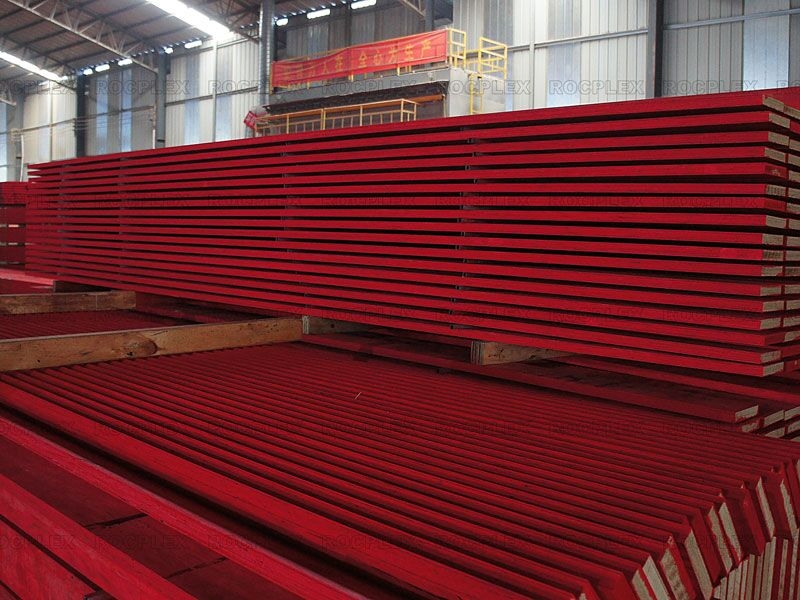LVL Form, short for Laminated Veneer Lumber Formwork, stands as an innovative and essential solution within the construction industry. This engineered wood product is purpose-built to serve as a versatile and resilient material, specifically crafted for shaping concrete structures throughout the construction process. Characterized by its layers of laminated veneer, LVL Form offers unparalleled strength, precision, and durability. Its role is pivotal in ensuring the successful realization of a wide range of concrete structures, encompassing walls, slabs, and columns, in diverse construction projects. The significance of the LVL Form lies in its capacity to furnish a dependable and uniform framework for concrete, thus assuring structural integrity and precision. Its advantages encompass increased load-bearing capability, decreased construction time, cost-efficiency, and eco-friendliness, rendering it an indispensable preference for builders and contractors alike.
What is LVL (Laminated Veneer Lumber)
LVL in a Nutshell
LVL, which stands for Laminated Veneer Lumber, is an engineered wood product with a distinctive composition. It is crafted by layering thin veneer sheets of wood and bonding them together using adhesive resins. These veneer layers are meticulously stacked with their grain orientations aligned in the same direction, resulting in a composite material celebrated for its exceptional structural integrity and strength. LVL’s production process involves the careful selection and precise alignment of veneers, ensuring a high level of consistency and eliminating many of the natural defects found in solid wood.
Noteworthy Properties and Characteristics
- Robust Strength: LVL is renowned for its remarkable strength-to-weight ratio, making it an ideal choice for applications demanding robust structural support.
- Impressive Stability: LVL exhibits minimal tendencies to warp, twist, or shrink, even when subjected to changing environmental conditions. This inherent stability ensures that LVL maintains its original shape and structural integrity over time.
- Consistent Uniformity: LVL’s manufacturing process guarantees uniformity in dimensions and properties throughout the material, reducing variability and enhancing predictability in construction projects.
- Versatility Unleashed: LVL can be easily cut, shaped, and customized to accommodate diverse construction requirements. Its versatility extends to both its size and its adaptability to various formwork applications.
The Case for LVL in Formwork
Choosing LVL for formwork in construction is underpinned by several compelling factors:
- Structural Confidence: LVL’s inherent strength and stability make it the go-to choice for formwork. It can effortlessly withstand the substantial loads imposed by wet concrete during pouring and curing, thereby ensuring the steadfastness of the formwork structure.
- Precision and Accuracy: LVL’s consistency and uniformity play a pivotal role in achieving precise and accurate concrete shaping. Builders and contractors can rely on LVL formwork to maintain the desired shape and dimensions of concrete elements, including walls, slabs, and columns.
- Resilient Durability: LVL is engineered to endure the rigors of construction sites. Its resistance to moisture, rot, and decay translates into a prolonged service life, reducing the need for frequent replacements.
- Cost-Effective Sustainability: While the initial investment in LVL formwork may exceed that of traditional materials, in the long run. Its durability and reusability result in significant cost savings. Contractors benefit from reduced replacement and maintenance costs, while the environment benefits from resource conservation. Because LVL is often made from sustainably sourced wood.
Types of LVL Formwork
Wall Formwork
LVL formwork serves as a fundamental tool in shaping concrete walls of varying sizes and designs. Its inherent strength and stability make it exceptionally well-suited for this purpose. Wall formwork systems utilizing LVL offer adjustability, enabling builders to effortlessly create walls of different heights and thicknesses. The uniformity of LVL ensures that the formwork maintains the intended shape, resulting in precisely formed and dimensionally accurate walls.

Slab Formwork
In the construction of horizontal concrete slabs, LVL formwork emerges as an indispensable asset. Whether applied to residential, commercial or industrial projects. LVL’s strong load-bearing capacity and resistance to bending make it an ideal choice. The LVL formwork system, designed for slab construction, simplifies the pouring and curing process of concrete. The result is a flat, level and structurally sound slab. This ensures that the floors of buildings not only maintain stability but also exhibit consistent quality.
Column Formwork
When the objective is to shape concrete columns, LVL formwork offers practical and versatile solutions. Its adaptability facilitates the construction of columns with varying diameters and heights. LVL’s dependable consistency in dimensions and stability plays a critical role in achieving precise and well-defined column shapes. Builders rely on LVL formwork systems to ensure that both the structural and aesthetic requirements of columns are met with confidence.
Specialized Applications
Beyond the confines of conventional formwork applications, LVL’s versatility extends to specialized and unconventional uses. It can be customized to meet the unique needs of curved or irregularly shaped concrete structures. Such as arches or artistic features. This is where LVL’s customization flexibility and warpage resistance come into play. Ensuring that even the most complex and artistic designs are realized with precision and efficiency.
Installation and Usage Guidelines
Step-by-Step Installation Process
- Preparation: Ensure thorough site preparation, including the creation of a level and stable foundation. Implement essential safety measures and set up the required equipment.
- Cutting and Assembly: Cut LVL formwork panels to the prescribed dimensions and meticulously assemble them according to the formwork design. Secure the panels firmly in place using appropriate supports and bracing.
- Formwork Inspection: Before the concrete pouring phase, conduct a comprehensive inspection of the LVL formwork for any defects, damage, or misalignment. Make necessary adjustments to achieve the desired shape and dimensions.
- Concrete Pouring: Carefully pour the concrete into the formwork, taking precautions to prevent the formation of air pockets and ensuring even distribution.
- Curing: Allow the concrete to undergo proper curing, adhering to industry-standard practices and recommended timeframes.
- Formwork Removal: Once the concrete has attained the required level of curing, proceed to carefully remove the LVL formwork panels, exercising caution to avoid any damage to the newly formed concrete structure during this crucial phase.
Safety Considerations
- Protective Gear: Ensure that all personnel involved in formwork installation and concrete pouring are equipped with suitable personal protective gear, including helmets, gloves, and safety goggles.
- Secure Fastening: Double-check the secure fastening of LVL formwork panels and their proper support to prevent inadvertent collapses or shifts during concrete pouring.
- Proper Ventilation: Maintain adequate ventilation in enclosed spaces to mitigate the risk of harmful fume accumulation during the curing process.
- Training and Supervision: Provide thorough training to workers in formwork installation and safety procedures. Additionally, enlist experienced supervisors to oversee the entire process, ensuring strict adherence to safety protocols.
Maintenance Tips
- Cleaning: After the formwork removal stage, diligently clean and store LVL panels to maximize their lifespan.
- Inspection: Implement regular inspections of LVL formwork to identify any indications of wear, damage, or deterioration. Promptly replace any panels that show signs of being compromised.
- Storage: Optimal storage of LVL formwork involves keeping it in a dry and well-ventilated area to safeguard against moisture-related issues such as warping.
- Reusability: Capitalize on the renowned reusability of LVL formwork by maintaining it properly and storing it appropriately. This practice enhances longevity and cost-effectiveness over numerous construction projects.
Comparison with Traditional Formwork
Plywood and Timber Formwork Advantages
Traditional formwork materials like plywood and timber have been mainstays in construction for years, offering distinct advantages:
- Readily Available: Plywood and timber are ubiquitous materials in the construction industry, ensuring easy sourcing.
- Cost-Effective for Small Projects: In the case of smaller-scale projects or those with budget constraints, plywood and timber formwork present cost-effective options.
- Ease of Handling: These materials are relatively lightweight and manageable, which proves advantageous for smaller construction teams.
- Local Sourcing: Plywood and timber can often be procured locally, reducing transportation costs and environmental impact.
Cost and Time Efficiency
In contrast to traditional materials, LVL formwork brings forth compelling advantages in terms of cost and time efficiency:
- Labor Cost Savings: LVL formwork’s user-friendly nature and reusability translate to reduced labor costs, thanks to quicker installation and removal.
- Accelerated Construction: The stability and precision of LVL formwork contribute to expedited and more efficient construction processes, ultimately saving time.
- Diminished Replacement Expenses: While the initial investment in LVL may surpass that of plywood or timber, its durability and reusability lead to reduced replacement costs across multiple projects.
- Reduced Material Waste: LVL formwork’s durability and reusability curtail material waste, thereby lowering disposal costs and lessening its environmental footprint.
Sustainability and Environmental Considerations
LVL as an Eco-Friendly Building Material
LVL garners increasing recognition as an eco-friendly building material due to several factors:
- Sustainable Sourcing: Many LVL manufacturers prioritize responsible timber sourcing practices, utilizing wood from sustainably managed forests.
- Resource Efficiency: LVL’s manufacturing process optimizes wood resource utilization, minimizing waste and maximizing efficiency.
- Energy Efficiency: LVL production typically consumes less energy compared to other construction materials, contributing to reduced carbon emissions.
- Longevity and Reusability: LVL’s longevity and reusability extend its lifecycle, diminishing the need for frequent replacements and reducing overall resource consumption.
Recycling and Reusability
LVL formwork’s recycling and reusability aspects align seamlessly with sustainable construction practices:
- Recycling: At the end of its lifecycle, LVL can be recycled, further reducing its environmental impact and promoting resource conservation.
- Reusability: LVL’s capacity for reuse across multiple construction projects minimizes waste generation and mitigates the demand for new formwork materials.
- Environmental Certification: Numerous LVL products conform to environmental certification standards, providing assurance of their sustainable attributes.
Elevate Your Construction with LVL Formwork: Build Stronger, Greener, and Smarter!
In the realm of construction, the LVL (Laminated Veneer Lumber) Form solution stands as a beacon of excellence. Its remarkable strength, precision, reusability, and sustainability set new standards for formwork materials. By optimizing efficiency, reducing costs, and minimizing environmental impact, LVL formwork has become an indispensable choice for builders and contractors worldwide. As it continues to evolve with emerging technologies and sustainable practices, LVL formwork paves the way for a more efficient, eco-friendly, and innovative future in the construction industry. Unleashing excellence, LVL formwork shapes the structures that shape our world.
Post time: 11 月-30-2023

